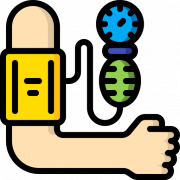
We’re here to help you stay as healthy as you possibly can, and that includes keeping your blood pressure within the normal range. We all know that blood pressure is important and many of us are encouraged to monitor ours at home, but how does this work? What does your reading mean and what can you do if you have high blood pressure?
What is blood pressure?
This is a measure of how hard your heart has to work to pump blood around your body. A blood pressure monitor will record the pressure of the blood in your arteries as it travels from your heart to other areas of your body.
What is considered a normal blood pressure range?
You might find that your healthcare practitioner has told you a number which is right for you based on your health and medical history. However the ideal blood pressure is between 90/60mmHG and 120/80mmHg, so a reading of 100/70mmHg is a good reading to have.
Everyone’s blood pressure can vary throughout the day depending on what you’re doing so you may be advised to measure your pressure at different times to get a more accurate picture of your overall blood pressure.
What is considered a high blood pressure reading?
Also known as hypertension, you’ll be considered to have high blood pressure if you have a reading of 140/90mmHG or higher. If your blood pressure is too high it can put a strain on your heart, blood vessels and other organs, which can increase your risk of conditions such as heart attacks, strokes or heart disease.
To find out whether you have high blood pressure you’ll need to have your blood pressure checked, as the condition presents no symptoms.
There are no set causes of high blood pressure, but certain things and circumstances can increase your risk, these include:
- Being over the age of 65
- Having a family history of high blood pressure or heart disease
- Being overweight
- Not exercising as much as you should
- Being of Asian or African-Caribbean descent
- Drinking more than two to three units of alcohol a day (up to 14 units a week) if you’re a woman, or three to four units a day (up to 21 units a week) if you’re a man
- A diet including a lot of salt. Adults should eat no more than 6g (1 teaspoon) of salt a day.
- Not eating five portions of fruit and vegetables a day
- Not getting enough sleep
- Drinking too much caffeine
What is considered a low blood pressure reading?
Less common that high blood pressure, low blood pressure doesn’t normally cause any symptoms. However if you frequently feel sick, faint, experience dizziness or feel weak then you should see a healthcare professional.
If you have low blood pressure your monitor would show a reading of 90/60mmHg or lower. Low blood pressure could be caused by pregnancy, medical conditions, the medication you are on or because you inherited it from your parents. If you are fit and healthy you might find that your blood pressure is low as well. The best way to find out if your blood pressure is low is to check it with a blood pressure monitor.
Balmoral Pharmacy blood pressure check
Did you know that we offer a blood pressure check service in store? During the check-up, we’ll check your blood pressure and explain what the numbers mean. If you have high blood pressure, we can give you advice on how simple changes to your diet and lifestyle can help lower your blood pressure. And, if necessary, we’ll refer you to your GP for treatment.
So, if you’re at all concerned, it’s a great way to get peace of mind or, if you are affected, you can start to take steps to improve your health. Find out more details on blood pressure testing and book an appointment today.
